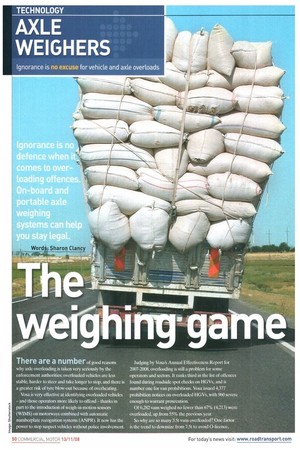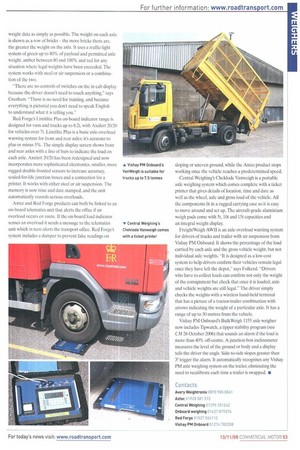There are a numberof g ood reasons why axle overloading is
Page 50

Page 51

Page 52

Page 53

If you've noticed an error in this article please click here to report it so we can fix it.
taken very seriously by the enforcement authorities: overloaded vehicles are less stable, harder to steer and take longer to stop, and there is a greater risk of tyre blow-out because of overheating.
Vosa is very effective at identifying overloaded vehicles — and those operators more likely to offend — thanks in part to the introduction of weigh-in-motion sensors (WIMS) on motorways combined with automatic numberplate recognition systems (ANPR). It now has the power to stop suspect vehicles without police involvement. Judging by Vosa 's Annual Effectiveness Report for 2007-2008, overloading is still a problem for some operators and sectors. It ranks third in the list of offences found during roadside spot cheeks on H0Vs. and is number one for van prohibitions. Vosa issued 4,377 prohibition notices on overloaded HGVs, with 960 severe enough to warrant prosecution.
016,282 vans weighed no fewer than 67% (4,213) were overloaded, up from 55% the previous year.
So why are so many 151 vans overloaded? One factor is the trend to downsize from 7.5t to avoid 0-licence, tachograph and driver-licensing issues, reckons Phil Bridge, sales office manager for on-board axle weighing specialists Red Forge: "Many van operators simply use the available cube and ignore axle or gross weights. You would be amazed at how many people believe that a Transit van can carry 3.5 tonnes of payload."
"Drivers are not always advised that a change from 7.5t to 3.5t comes with a significant downsizing in payload capacity as well," says Sean Folkard. sales and marketing director of Vishay PM Onboard. "On multi-drop operations, for example, they need training to understand the risk of overloading the front axle."
Nor is overloading simply a road safety issue for operators. Prohibitions will affect your Operator Compliance Risk Score (OCRS) data. And on a more pragmatic front, wear on tyres and mechanical components will increase, so maintenance costs will be higher. If the vehicle is involved in a crash and shown to be overloaded, your insurance will be invalidated.
Weighing on the move "Operators have been taking compliance more seriously and investing in axle-weighing equipment to stay legal," says Keith Gresham, the managing director of axleweighing specialist Axtec. "The choice of axle-weighing equipment depends on the load and operation. Depot weighbridges or portable weigh pads are more economical for point-to-point operations and where checkweighing each vehicle is routine because one weighing system covers numerous vehicles."
Richard Stokes, managing director at Central Weighing, says that for many operators portable weighing systems are the cheaper option.
"Everyone is now more aware that you need to checkweigh vehicles to ensure you stay legal," he argues, -but many hire vehicles and trailers do not have on-board weighing systems. For small fleets a portable weighing system will do the job more cheaply than an on-hoard system on every vehicle."
On-board weighing systems On-board weighing systems not only ensure the vehicle stays legal; on operations such as bulk haulage and waste collection they also help utilise every kilogram of payload.
On-board weighing systems are proving useful for some operators with 7.5t trucks, says Gresham: "On plant-hire operations, drivers collecting plant are often asked to accept a second item and the driver has no means of knowing how heavy the item is, or where to place it on the vehicle to avoid an axle overload."
Road-mending or environmental services crews are certainly a potential market, where additional load in the form of waste material is added to the vehicle once it has left the depot. And scaffolding operations are another. "Drivers simply put as many poles in the back as they can," Bridges points out.
Some operations carry a heightened risk of front-axle overloads. On a 7.5t fridge vehicle, for example, there is extra weight on the front axle from the refrigeration equipment and the load needs to be positioned towards the rear to compensate.
With multi-drop operations there is a risk that a vehicle which is legal when it leaves the depot might not be once it is half-way through the delivery round, thanks to the diminishing-load effect. As packages are removed from the rear, the centre of Emily of the load shifts forwards, potentially overloading the front axle.
Load tolerance Load tolerance is a good indicator of how liable a particular van or truck's axles may be to overloading. It is easy to calculate: simply add together the plated axle weights and subtract the gross vehicle weight. The smaller the resultant figure, the less load tolerance the vehicle has, and the greater the risk of accidental overload.
The technology There are two types of on-board axle weighing systems: those that are simply axle-load indicators and those that actually weigh the axle. The main difference is in the level of accuracy. Load indicators typically have an accuracy of plus or minus 5% (within Vosa guidelines), whereas those designed for weighing are plus or minus 0.5% The rule of thumb, inevitably, is that the more accurate a sensor is, the more expensive it is.
Axle load measuring systems incorporate either electronic sensors or analogue load cells using the strain-gauge principle with software that converts the analogue data into a digital format. Each load beam has one or more strain gauges through which an electrical current continually passes. As the wire in the gauge stretches under load, it alters the amount of electrical resistance. The microprocessor in the cab converts this change in resistance into kilograms of load imposed on the cell.
On trailers with air-suspension, changes in air bag pressure are measured.
"For most operators, a basic low-cost axle-load indicator with an accuracy to plus or minus 59,0 is perfectly adequate," says Red Forge's Bridges. "If you don't need to know the exact weight you are carrying, analogue cells will fit the bill and they can be retrofitted without removing the body."
"Modern analogue measuring systems are simple to fit and more reliable," according to Axtec's Gresham. "Systems are pre-cabled and the plug-and-play system eliminates the junction box. There are just three contact points: the front and rear sensors, and the load indicator in the cab."
Gresham points out that analogue systems need calibrating when they are first installed and preferably they should be checked every six months, but he adds that an analogue system costs significantly less than its electronic counterpart.
Doncaster-based Barry Napper's onboard weighing division incorporates load cells from US-manufacturer Vulcan and builds each system to suit the operation.
Avery Weigh-Tronix has pioneered the use of digitalload-cell technology for bulk-transport operations. The four-wire cabling typical for analogue load sensors is reduced to a single two-core 'daisy-chain' wiring configu ration which reduces the amount of cable required and eliminates the need for a junction box. A four-load cell system only needs eight chassis contacts. "Historically, most in-service faults occur in the chassis cable and connector system due to damage or temporary moisture ingress into plugs and sockets," says Chris McAllister. sales and marketing director. "Our two-wire system is more reliable than a four-wire analogue systems because it simplifies the cabling. Reliability is also better because the temporary presence of moisture in connectors will not affect digital data transmission, whereas in an analogue system this would stop it working."
The equipment
Recognition of the high incidence of van overloading has prompted the an-board weighing companies to develop systems specifically for lighter vehicles. These are simpler and cheaper than the more sophisticated products used on bulkers and waste collection vehicles.
Despite its name, Van Weigh from Vishay PM Onboard suits trucks up to 7.5t. It displays front and rear axle weights and overall gross weight, showing the percentage of the load on each axle, with audible and visual warnings once the load reaches 90% of legal weight.
Axtec has developed a new in-cab display for its OnBoard Axle Load Indicator system which shows the weight data as simply as possible. The weight on each axle is shown as a row of bricks — the more bricks there are, the greater the weight on the axle. It uses a traffic-light system of green up to 80% of payload and permitted axle weight, amber between 80 and 100% and red for any situation where legal weights have been exceeded. The system works with steel or air suspension or a combination of the two.
"There are no controls of switches on the in-cab display because the driver doesn't need to touch anything," says Gresham. "There is no need for training, and because everything is pictorial you don't need to speak English to understand what it is telling you."
Red Forge's Limitlite Plus on-board indicator range is designed for vans and trucks up to 8.2t, with Axalert 20/20 for vehicles over 7t. Limitlite Plus is a basic axle-overload warning system for front and rear axles; it's accurate to plus or minus 5%. The simple display screen shows front and rear axles with a line of bars to indicate the load on each axle. Axalert 20/20 has been redesigned and now incorporates more sophisticated electronics, smaller, more rugged double-fronted sensors to increase accuracy, sealed-for-life junction boxes and a connection for a printer. It works with either steel or air suspension. The memory is now time and date stamped, and the unit automatically records serious overloads.
Axtec and Red Forge products can both he linked to an on-board telematics unit that alerts the office if an overload occurs en route. If the on-board load indicator senses an overload it sends a message to the telematics unit which in turn alerts the transport office. Red Forge's system includes a damper to prevent false readings on sloping or uneven ground, while the Axtec product stops working once the vehicle reaches a predetermined speed.
Central Weighing's Cheklode Vanweigh is a portable axle weighing system which comes complete with a ticket printer that gives details of location, time and date as well as the wheel, axle and gross load of the vehicle. All the components fit in a rugged carrying case so it is easy to move around and set up. The aircraft-grade aluminium weigh pads come with 5t, 10t and 15t capacities and an integral weight display.
Freight Weigh AWII is an axle overload warning system for drivers of trucks and trailer with air suspension from Vishay PM Onboard. It shows the percentage of the load carried by each axle and the gross vehicle weight, but not individual axle weights. "It is designed as a low-cost system to help drivers confirm their vehicles remain legal once they have left the depot," says Folkerd. "Drivers who have to collect loads can confirm not only the weight of the consignment but check that once it is loaded, axle and vehicle weights are still legal." The driver simply checks the weights with a wireless hand-held terminal that has a picture of a tractor-trailer combination with arrows indicating the weight of a particular axle. It has a range of up to 30 metres from the vehicle.
Vishay PM Onboard's BulkWeigh 1155 axle weigher now includes lipwatch, a tipper stability program (see CM 26 October 2006) that sounds an alarm if the load is more than 40% off-centre. A junction-box inclinometer measures the level of the ground or body and a display tells the driver the angle. Side-to-side slopes greater than 3 trigger the alarm. It automatically recognises any Vishay PM axle weighing system on the trailer, eliminating the need to recalibrate each time a trailer is swapped. •












































































































































































